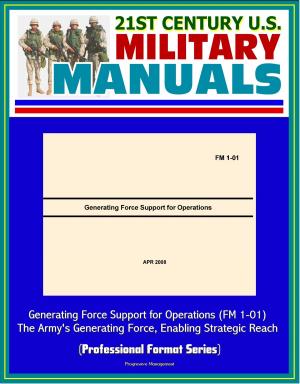America's Conditional Advantage: Airpower, Counterinsurgency, and the Theory of John Warden - COIN, Airpower, French-Algerian War, Vietnam, Soviet Afghan War, Enemy as a System (EAS)
Nonfiction, History, Military, Vietnam War, Asian| Author: | Progressive Management | ISBN: | 9781311075307 |
| Publisher: | Progressive Management | Publication: | April 26, 2015 |
| Imprint: | Smashwords Edition | Language: | English |
| Author: | Progressive Management |
| ISBN: | 9781311075307 |
| Publisher: | Progressive Management |
| Publication: | April 26, 2015 |
| Imprint: | Smashwords Edition |
| Language: | English |
Professionally converted for accurate flowing-text e-book format reproduction, this study is a theoretical and historical exploration of the role and relevance of airpower in counterinsurgency (COIN). Despite an overwhelming material advantage in airpower and the popular belief that this provides America with an inherently beneficial warfighting asymmetry, the US struggles to realize the full value of airpower in COIN. The author proposes that airpower provides the US with a conditional advantage that must be deliberately unlocked through strategic deliberation. The author further proposes that a distinct theory of airpower for COIN is needed to foster and guide strategy formulation in order to optimize the application of airpower in this growing mission area. As a first step in developing this proposed theory, the author applies an existing airpower theory, Colonel John Warden's Enemy as a System, to three distinct historical cases in search of meaningful patterns.
After conditioning Warden's theory to account for the unique attributes of insurgent organizations, this study applies an analytical framework based on Enemy as a System in examining airpower operations in the French-Algerian War, the Vietnam War, and the Soviet-Afghan War. In each case, the framework examines how airpower was applied to key vulnerabilities within the insurgent organizational system, how such application impacted enemy behavior, and the overall relationship between the character of airpower operations and strategic outcomes. The findings derived from this analysis demonstrate that Warden's theory (1) unlocks the conditional advantage of airpower in COIN by explaining and guiding airpower strategy; (2) demonstrates how COIN requires a fundamentally different airpower approach than Major Combat Operations; and (3) shows the grave risks of airpower application in COIN absent a deliberate strategy.
In each of the three cases examined, counterinsurgents applied airpower in ways that failed to account for the realities of the insurgent organizational system and were insensitive to both the degree of immersion of the enemy within the local population and the critical need to earn population support. As a result, airpower operations were inordinately physical in their approach to a predominantly non-physical phenomenon, and were not properly shaped to support the goal of gaining and maintaining popular allegiance and legitimacy. The author draws clear links between these strategic missteps and the defeat of three established powers, each of which undertook COIN with an overwhelming material advantage in airpower but could not translate it into a battlefield advantage. In the closing chapter, the author demonstrates that airpower, when not properly shaped by strategic deliberation, can actually serve as a disadvantage to those who possess it asymmetrically. The author proposes that by applying a theoretical template such as Enemy as a System to the shaping of airpower in COIN, the US can avoid incurring this airpower penalty and optimize the role and relevance of airpower in defeating insurgent organizations. Organizational and policy recommendations accompany this finding.
Professionally converted for accurate flowing-text e-book format reproduction, this study is a theoretical and historical exploration of the role and relevance of airpower in counterinsurgency (COIN). Despite an overwhelming material advantage in airpower and the popular belief that this provides America with an inherently beneficial warfighting asymmetry, the US struggles to realize the full value of airpower in COIN. The author proposes that airpower provides the US with a conditional advantage that must be deliberately unlocked through strategic deliberation. The author further proposes that a distinct theory of airpower for COIN is needed to foster and guide strategy formulation in order to optimize the application of airpower in this growing mission area. As a first step in developing this proposed theory, the author applies an existing airpower theory, Colonel John Warden's Enemy as a System, to three distinct historical cases in search of meaningful patterns.
After conditioning Warden's theory to account for the unique attributes of insurgent organizations, this study applies an analytical framework based on Enemy as a System in examining airpower operations in the French-Algerian War, the Vietnam War, and the Soviet-Afghan War. In each case, the framework examines how airpower was applied to key vulnerabilities within the insurgent organizational system, how such application impacted enemy behavior, and the overall relationship between the character of airpower operations and strategic outcomes. The findings derived from this analysis demonstrate that Warden's theory (1) unlocks the conditional advantage of airpower in COIN by explaining and guiding airpower strategy; (2) demonstrates how COIN requires a fundamentally different airpower approach than Major Combat Operations; and (3) shows the grave risks of airpower application in COIN absent a deliberate strategy.
In each of the three cases examined, counterinsurgents applied airpower in ways that failed to account for the realities of the insurgent organizational system and were insensitive to both the degree of immersion of the enemy within the local population and the critical need to earn population support. As a result, airpower operations were inordinately physical in their approach to a predominantly non-physical phenomenon, and were not properly shaped to support the goal of gaining and maintaining popular allegiance and legitimacy. The author draws clear links between these strategic missteps and the defeat of three established powers, each of which undertook COIN with an overwhelming material advantage in airpower but could not translate it into a battlefield advantage. In the closing chapter, the author demonstrates that airpower, when not properly shaped by strategic deliberation, can actually serve as a disadvantage to those who possess it asymmetrically. The author proposes that by applying a theoretical template such as Enemy as a System to the shaping of airpower in COIN, the US can avoid incurring this airpower penalty and optimize the role and relevance of airpower in defeating insurgent organizations. Organizational and policy recommendations accompany this finding.















